Exploring the Dahlgren and Whitehead Health Determinants Model Report
VerifiedAdded on 2020/02/19
|11
|3214
|135
Report
AI Summary
This report provides a comprehensive analysis of the Dahlgren and Whitehead Health Determinants Model, exploring the complex interplay of social, economic, and environmental factors that influence health outcomes. It examines the model's framework, including the individual at the center, surrounded by layers of influence such as lifestyle, community, living and working conditions, and broader socioeconomic factors. The report delves into the historical context of public health, highlighting key stages and interventions, such as the Black Report and the evolution of public health promotion. It also discusses the impact of sex and gender on health, inequalities within society, and the specific healthcare needs of older adults. The report further analyzes how social inequalities, resource distribution, and the complexities of modern society contribute to disparities in health. Finally, it addresses the healthcare utilization patterns of older adults, the challenges of care fragmentation, and the role of healthcare services in improving health outcomes, including access to medications and preventative care.

Running head: THE DAHLGREN AND WHITEHEAD 1
The Dahlgren and Whitehead Health Determinants Model
Name
Institutional Affiliation
The Dahlgren and Whitehead Health Determinants Model
Name
Institutional Affiliation
Paraphrase This Document
Need a fresh take? Get an instant paraphrase of this document with our AI Paraphraser
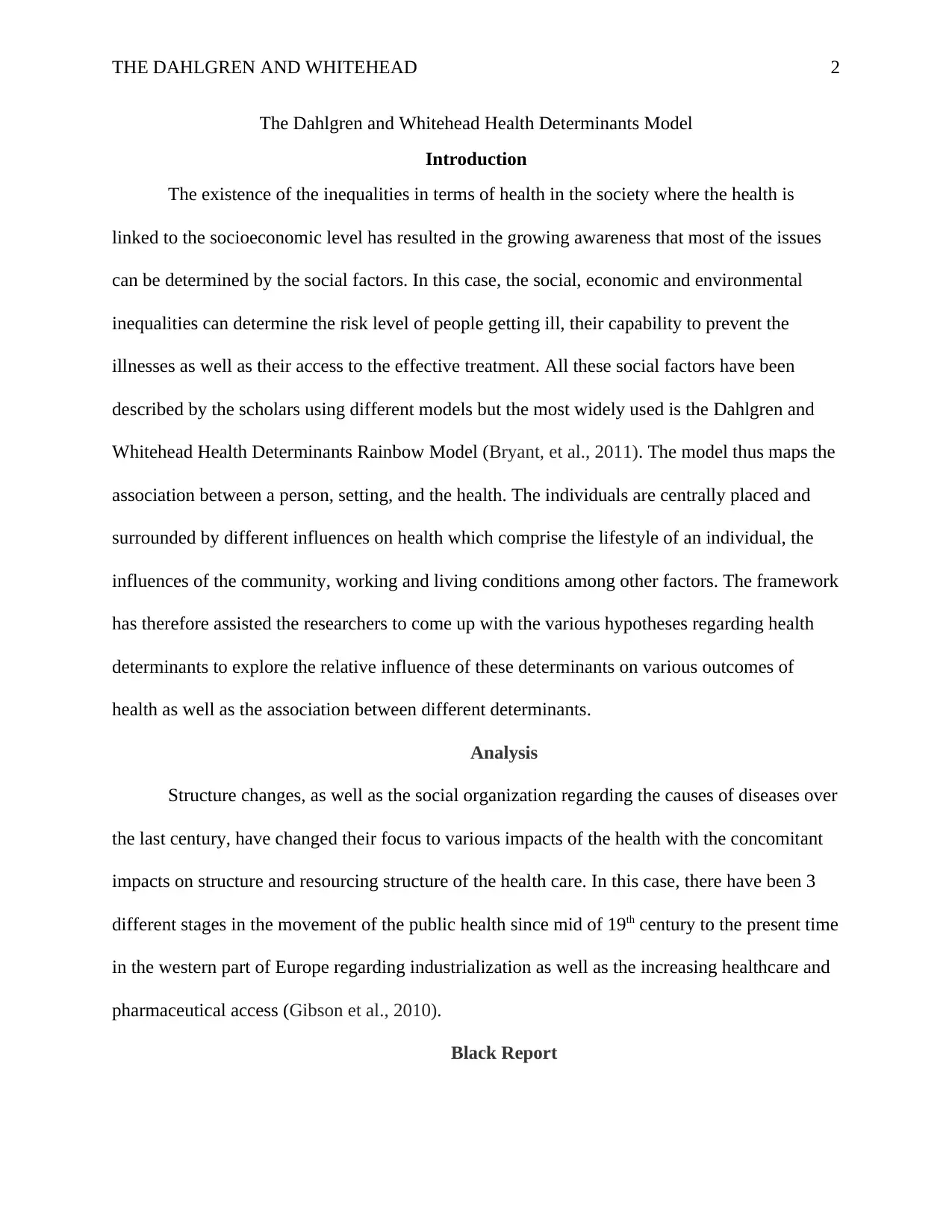
THE DAHLGREN AND WHITEHEAD 2
The Dahlgren and Whitehead Health Determinants Model
Introduction
The existence of the inequalities in terms of health in the society where the health is
linked to the socioeconomic level has resulted in the growing awareness that most of the issues
can be determined by the social factors. In this case, the social, economic and environmental
inequalities can determine the risk level of people getting ill, their capability to prevent the
illnesses as well as their access to the effective treatment. All these social factors have been
described by the scholars using different models but the most widely used is the Dahlgren and
Whitehead Health Determinants Rainbow Model (Bryant, et al., 2011). The model thus maps the
association between a person, setting, and the health. The individuals are centrally placed and
surrounded by different influences on health which comprise the lifestyle of an individual, the
influences of the community, working and living conditions among other factors. The framework
has therefore assisted the researchers to come up with the various hypotheses regarding health
determinants to explore the relative influence of these determinants on various outcomes of
health as well as the association between different determinants.
Analysis
Structure changes, as well as the social organization regarding the causes of diseases over
the last century, have changed their focus to various impacts of the health with the concomitant
impacts on structure and resourcing structure of the health care. In this case, there have been 3
different stages in the movement of the public health since mid of 19th century to the present time
in the western part of Europe regarding industrialization as well as the increasing healthcare and
pharmaceutical access (Gibson et al., 2010).
Black Report
The Dahlgren and Whitehead Health Determinants Model
Introduction
The existence of the inequalities in terms of health in the society where the health is
linked to the socioeconomic level has resulted in the growing awareness that most of the issues
can be determined by the social factors. In this case, the social, economic and environmental
inequalities can determine the risk level of people getting ill, their capability to prevent the
illnesses as well as their access to the effective treatment. All these social factors have been
described by the scholars using different models but the most widely used is the Dahlgren and
Whitehead Health Determinants Rainbow Model (Bryant, et al., 2011). The model thus maps the
association between a person, setting, and the health. The individuals are centrally placed and
surrounded by different influences on health which comprise the lifestyle of an individual, the
influences of the community, working and living conditions among other factors. The framework
has therefore assisted the researchers to come up with the various hypotheses regarding health
determinants to explore the relative influence of these determinants on various outcomes of
health as well as the association between different determinants.
Analysis
Structure changes, as well as the social organization regarding the causes of diseases over
the last century, have changed their focus to various impacts of the health with the concomitant
impacts on structure and resourcing structure of the health care. In this case, there have been 3
different stages in the movement of the public health since mid of 19th century to the present time
in the western part of Europe regarding industrialization as well as the increasing healthcare and
pharmaceutical access (Gibson et al., 2010).
Black Report
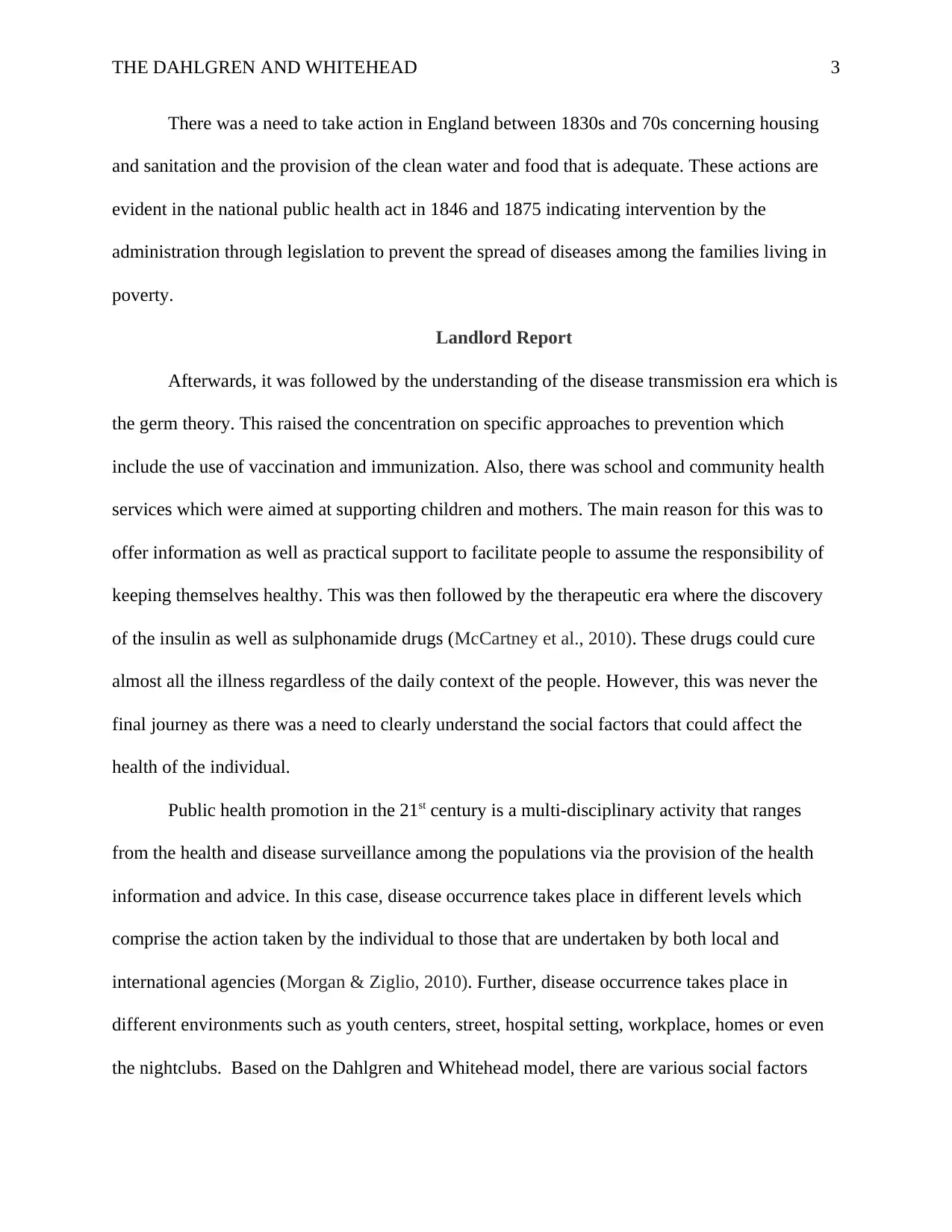
THE DAHLGREN AND WHITEHEAD 3
There was a need to take action in England between 1830s and 70s concerning housing
and sanitation and the provision of the clean water and food that is adequate. These actions are
evident in the national public health act in 1846 and 1875 indicating intervention by the
administration through legislation to prevent the spread of diseases among the families living in
poverty.
Landlord Report
Afterwards, it was followed by the understanding of the disease transmission era which is
the germ theory. This raised the concentration on specific approaches to prevention which
include the use of vaccination and immunization. Also, there was school and community health
services which were aimed at supporting children and mothers. The main reason for this was to
offer information as well as practical support to facilitate people to assume the responsibility of
keeping themselves healthy. This was then followed by the therapeutic era where the discovery
of the insulin as well as sulphonamide drugs (McCartney et al., 2010). These drugs could cure
almost all the illness regardless of the daily context of the people. However, this was never the
final journey as there was a need to clearly understand the social factors that could affect the
health of the individual.
Public health promotion in the 21st century is a multi-disciplinary activity that ranges
from the health and disease surveillance among the populations via the provision of the health
information and advice. In this case, disease occurrence takes place in different levels which
comprise the action taken by the individual to those that are undertaken by both local and
international agencies (Morgan & Ziglio, 2010). Further, disease occurrence takes place in
different environments such as youth centers, street, hospital setting, workplace, homes or even
the nightclubs. Based on the Dahlgren and Whitehead model, there are various social factors
There was a need to take action in England between 1830s and 70s concerning housing
and sanitation and the provision of the clean water and food that is adequate. These actions are
evident in the national public health act in 1846 and 1875 indicating intervention by the
administration through legislation to prevent the spread of diseases among the families living in
poverty.
Landlord Report
Afterwards, it was followed by the understanding of the disease transmission era which is
the germ theory. This raised the concentration on specific approaches to prevention which
include the use of vaccination and immunization. Also, there was school and community health
services which were aimed at supporting children and mothers. The main reason for this was to
offer information as well as practical support to facilitate people to assume the responsibility of
keeping themselves healthy. This was then followed by the therapeutic era where the discovery
of the insulin as well as sulphonamide drugs (McCartney et al., 2010). These drugs could cure
almost all the illness regardless of the daily context of the people. However, this was never the
final journey as there was a need to clearly understand the social factors that could affect the
health of the individual.
Public health promotion in the 21st century is a multi-disciplinary activity that ranges
from the health and disease surveillance among the populations via the provision of the health
information and advice. In this case, disease occurrence takes place in different levels which
comprise the action taken by the individual to those that are undertaken by both local and
international agencies (Morgan & Ziglio, 2010). Further, disease occurrence takes place in
different environments such as youth centers, street, hospital setting, workplace, homes or even
the nightclubs. Based on the Dahlgren and Whitehead model, there are various social factors
⊘ This is a preview!⊘
Do you want full access?
Subscribe today to unlock all pages.

Trusted by 1+ million students worldwide
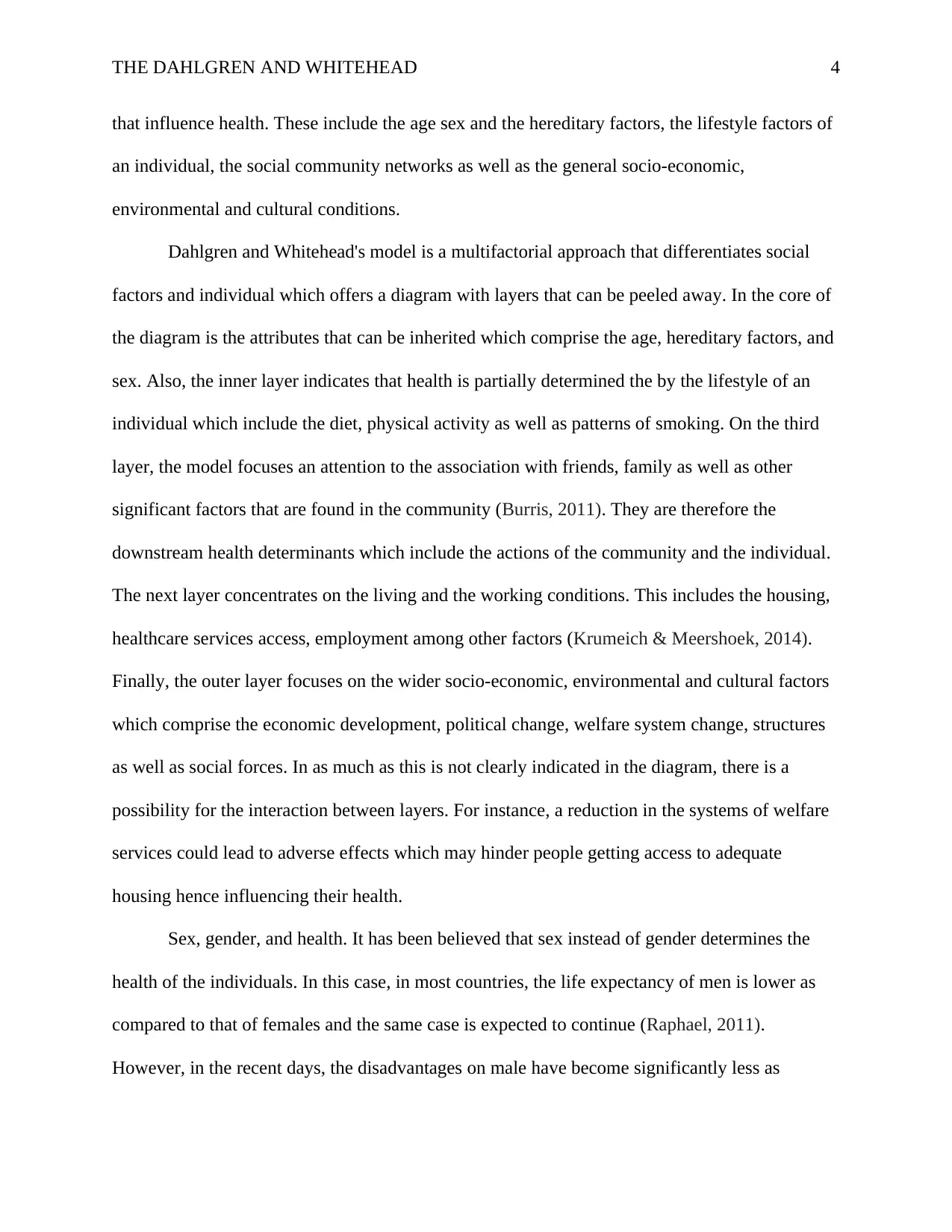
THE DAHLGREN AND WHITEHEAD 4
that influence health. These include the age sex and the hereditary factors, the lifestyle factors of
an individual, the social community networks as well as the general socio-economic,
environmental and cultural conditions.
Dahlgren and Whitehead's model is a multifactorial approach that differentiates social
factors and individual which offers a diagram with layers that can be peeled away. In the core of
the diagram is the attributes that can be inherited which comprise the age, hereditary factors, and
sex. Also, the inner layer indicates that health is partially determined the by the lifestyle of an
individual which include the diet, physical activity as well as patterns of smoking. On the third
layer, the model focuses an attention to the association with friends, family as well as other
significant factors that are found in the community (Burris, 2011). They are therefore the
downstream health determinants which include the actions of the community and the individual.
The next layer concentrates on the living and the working conditions. This includes the housing,
healthcare services access, employment among other factors (Krumeich & Meershoek, 2014).
Finally, the outer layer focuses on the wider socio-economic, environmental and cultural factors
which comprise the economic development, political change, welfare system change, structures
as well as social forces. In as much as this is not clearly indicated in the diagram, there is a
possibility for the interaction between layers. For instance, a reduction in the systems of welfare
services could lead to adverse effects which may hinder people getting access to adequate
housing hence influencing their health.
Sex, gender, and health. It has been believed that sex instead of gender determines the
health of the individuals. In this case, in most countries, the life expectancy of men is lower as
compared to that of females and the same case is expected to continue (Raphael, 2011).
However, in the recent days, the disadvantages on male have become significantly less as
that influence health. These include the age sex and the hereditary factors, the lifestyle factors of
an individual, the social community networks as well as the general socio-economic,
environmental and cultural conditions.
Dahlgren and Whitehead's model is a multifactorial approach that differentiates social
factors and individual which offers a diagram with layers that can be peeled away. In the core of
the diagram is the attributes that can be inherited which comprise the age, hereditary factors, and
sex. Also, the inner layer indicates that health is partially determined the by the lifestyle of an
individual which include the diet, physical activity as well as patterns of smoking. On the third
layer, the model focuses an attention to the association with friends, family as well as other
significant factors that are found in the community (Burris, 2011). They are therefore the
downstream health determinants which include the actions of the community and the individual.
The next layer concentrates on the living and the working conditions. This includes the housing,
healthcare services access, employment among other factors (Krumeich & Meershoek, 2014).
Finally, the outer layer focuses on the wider socio-economic, environmental and cultural factors
which comprise the economic development, political change, welfare system change, structures
as well as social forces. In as much as this is not clearly indicated in the diagram, there is a
possibility for the interaction between layers. For instance, a reduction in the systems of welfare
services could lead to adverse effects which may hinder people getting access to adequate
housing hence influencing their health.
Sex, gender, and health. It has been believed that sex instead of gender determines the
health of the individuals. In this case, in most countries, the life expectancy of men is lower as
compared to that of females and the same case is expected to continue (Raphael, 2011).
However, in the recent days, the disadvantages on male have become significantly less as
Paraphrase This Document
Need a fresh take? Get an instant paraphrase of this document with our AI Paraphraser

THE DAHLGREN AND WHITEHEAD 5
compared to before. For instance in Wales and England, between 1970 and 2003, the life
expectancy of the male has increased by four years whereas the life expectancy of the women
has increased by only three years (Mogford, Gould & DeVoght, 2010). Therefore, given the
assumption that women are biologically advantaged regarding the life expectancy, this
assumption can be challenged. The changes can be attributed to various factors such as the
improved healthcare services as a result of improved healthcare re system. Also, many men have
been educated on the dangers of different lifestyles which should endanger their life’s hence their
life expectancy has increased.
Inequalities and disparities exist between various groups in the society. The main reason
for this inequality is an uneven distribution of the resources specifically based on the allocation
norms which favor specific groups of persons. The difference in allocation of the resources in the
society is brought about by the factors such as sexual orientation, kinship, age, ethnicity, health
care, the source of wealth, political representation, education as well as the freedom of speech
among other factors (Baum et al., 2013). The social inequality that is associated with the
economic inequality is based on the unequal distribution of the wealth and income. In as much as
economics and sociology use varied terms theoretical techniques to assess and describe the
economic inequality, both fields are more concerned with the understanding of this issue. Due to
the uneven distribution of the resources in the society, it leads to some people having more
resources while others having none or less. This creates a scenario of social class within a society
where those that are favored in terms of resource distribution are prioritized in terms of service
delivery as compared to those that are resource poor.
Social inequality is fashioned by various factors that are structural which comprise the
geographical location or the status of the population which is mainly underpinned by cultural
compared to before. For instance in Wales and England, between 1970 and 2003, the life
expectancy of the male has increased by four years whereas the life expectancy of the women
has increased by only three years (Mogford, Gould & DeVoght, 2010). Therefore, given the
assumption that women are biologically advantaged regarding the life expectancy, this
assumption can be challenged. The changes can be attributed to various factors such as the
improved healthcare services as a result of improved healthcare re system. Also, many men have
been educated on the dangers of different lifestyles which should endanger their life’s hence their
life expectancy has increased.
Inequalities and disparities exist between various groups in the society. The main reason
for this inequality is an uneven distribution of the resources specifically based on the allocation
norms which favor specific groups of persons. The difference in allocation of the resources in the
society is brought about by the factors such as sexual orientation, kinship, age, ethnicity, health
care, the source of wealth, political representation, education as well as the freedom of speech
among other factors (Baum et al., 2013). The social inequality that is associated with the
economic inequality is based on the unequal distribution of the wealth and income. In as much as
economics and sociology use varied terms theoretical techniques to assess and describe the
economic inequality, both fields are more concerned with the understanding of this issue. Due to
the uneven distribution of the resources in the society, it leads to some people having more
resources while others having none or less. This creates a scenario of social class within a society
where those that are favored in terms of resource distribution are prioritized in terms of service
delivery as compared to those that are resource poor.
Social inequality is fashioned by various factors that are structural which comprise the
geographical location or the status of the population which is mainly underpinned by cultural
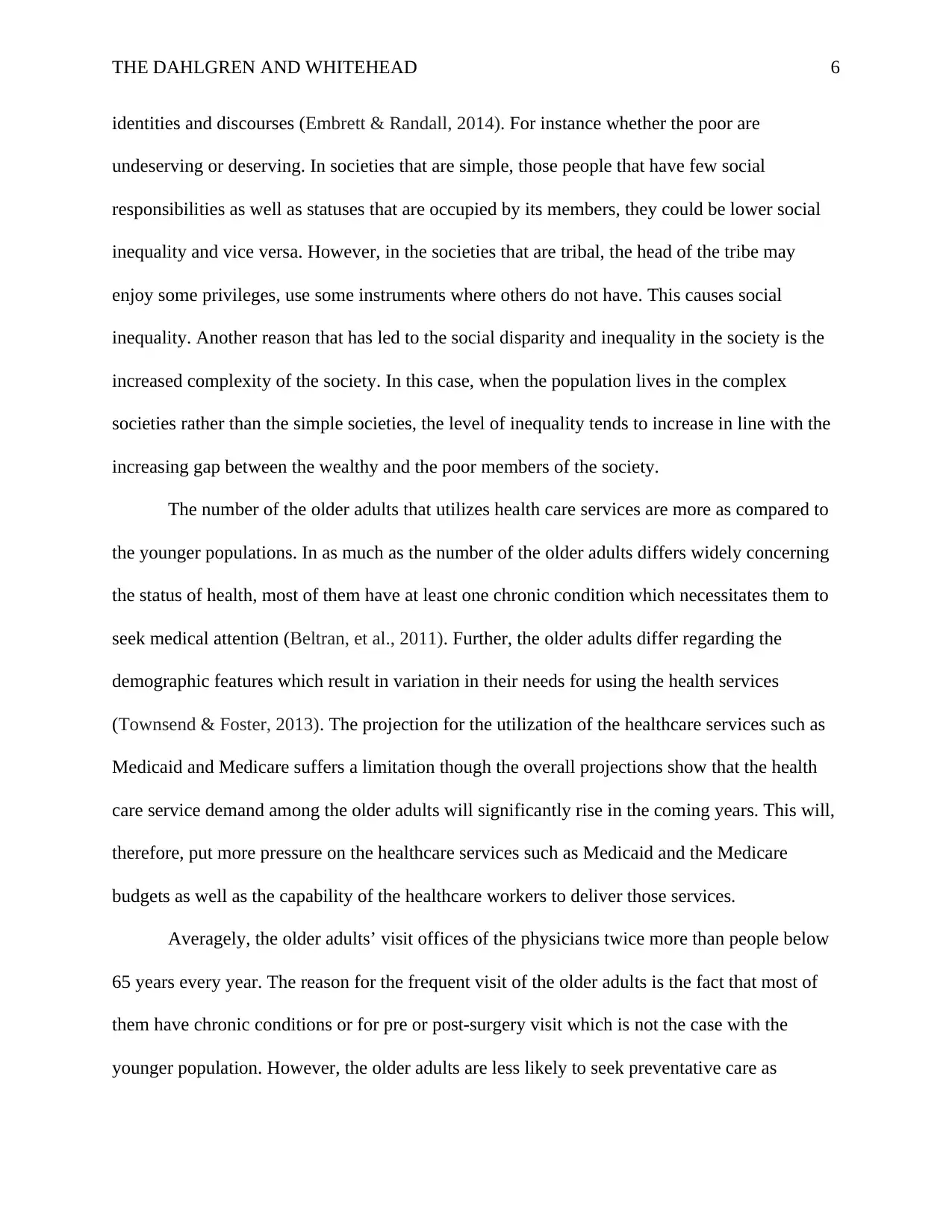
THE DAHLGREN AND WHITEHEAD 6
identities and discourses (Embrett & Randall, 2014). For instance whether the poor are
undeserving or deserving. In societies that are simple, those people that have few social
responsibilities as well as statuses that are occupied by its members, they could be lower social
inequality and vice versa. However, in the societies that are tribal, the head of the tribe may
enjoy some privileges, use some instruments where others do not have. This causes social
inequality. Another reason that has led to the social disparity and inequality in the society is the
increased complexity of the society. In this case, when the population lives in the complex
societies rather than the simple societies, the level of inequality tends to increase in line with the
increasing gap between the wealthy and the poor members of the society.
The number of the older adults that utilizes health care services are more as compared to
the younger populations. In as much as the number of the older adults differs widely concerning
the status of health, most of them have at least one chronic condition which necessitates them to
seek medical attention (Beltran, et al., 2011). Further, the older adults differ regarding the
demographic features which result in variation in their needs for using the health services
(Townsend & Foster, 2013). The projection for the utilization of the healthcare services such as
Medicaid and Medicare suffers a limitation though the overall projections show that the health
care service demand among the older adults will significantly rise in the coming years. This will,
therefore, put more pressure on the healthcare services such as Medicaid and the Medicare
budgets as well as the capability of the healthcare workers to deliver those services.
Averagely, the older adults’ visit offices of the physicians twice more than people below
65 years every year. The reason for the frequent visit of the older adults is the fact that most of
them have chronic conditions or for pre or post-surgery visit which is not the case with the
younger population. However, the older adults are less likely to seek preventative care as
identities and discourses (Embrett & Randall, 2014). For instance whether the poor are
undeserving or deserving. In societies that are simple, those people that have few social
responsibilities as well as statuses that are occupied by its members, they could be lower social
inequality and vice versa. However, in the societies that are tribal, the head of the tribe may
enjoy some privileges, use some instruments where others do not have. This causes social
inequality. Another reason that has led to the social disparity and inequality in the society is the
increased complexity of the society. In this case, when the population lives in the complex
societies rather than the simple societies, the level of inequality tends to increase in line with the
increasing gap between the wealthy and the poor members of the society.
The number of the older adults that utilizes health care services are more as compared to
the younger populations. In as much as the number of the older adults differs widely concerning
the status of health, most of them have at least one chronic condition which necessitates them to
seek medical attention (Beltran, et al., 2011). Further, the older adults differ regarding the
demographic features which result in variation in their needs for using the health services
(Townsend & Foster, 2013). The projection for the utilization of the healthcare services such as
Medicaid and Medicare suffers a limitation though the overall projections show that the health
care service demand among the older adults will significantly rise in the coming years. This will,
therefore, put more pressure on the healthcare services such as Medicaid and the Medicare
budgets as well as the capability of the healthcare workers to deliver those services.
Averagely, the older adults’ visit offices of the physicians twice more than people below
65 years every year. The reason for the frequent visit of the older adults is the fact that most of
them have chronic conditions or for pre or post-surgery visit which is not the case with the
younger population. However, the older adults are less likely to seek preventative care as
⊘ This is a preview!⊘
Do you want full access?
Subscribe today to unlock all pages.

Trusted by 1+ million students worldwide

THE DAHLGREN AND WHITEHEAD 7
compared to the young adults (Potvin, 2012). Some of the chronic conditions that affect the older
adults and make them regular users of the healthcare services include hypertension, diabetes,
cancer, heart disease and joint problems. Most of them, therefore, tend to seek medical attention
form the health care providers. Due to these visits, it helps in the improvement of the health
outcome of the older adults since the healthcare services offer them the best opportunity to find
appropriate care form different healthcare facilities.
The older adults are particularly vulnerable as they move between different types of care.
Since there is no proper coordination among the healthcare providers in different environments,
this can lead to the care fragmentation which therefore places the older adults at high risk for
duplication or absence of the required services that would address the condition at hand. The
vulnerability also increases due to stress which is due to the movement from one facility to
another in search of the care (Koh et al., 2010). The changes in medication as a result of facility
change lead to adverse effects of drugs which will lead the transition of care form the hospital
setting to the long-term care setting such as the nursing home or the private home settings
(Barton & Grant, 2013). Also, there are instances of incomplete procedure during discharge from
the hospitals which may be associated with the re-hospitalization that is unnecessary (Jinks, Ong
& O'Neill, 2010). Further, this kind of care fragmentation may be due to the poor coordination
between the care providers who care for the older adults in different environmental settings
hence increasing the failure to meet the standards of care quality.
The health care services have ensured that the older adults have access to wide variety of
healthcare services. This includes the provision of the appropriate drugs that help in treating their
chronic conditions. In this case, the medical services foot out some bills for the older adults who
consume most of the over the counter medications. Some of these medications that are widely
compared to the young adults (Potvin, 2012). Some of the chronic conditions that affect the older
adults and make them regular users of the healthcare services include hypertension, diabetes,
cancer, heart disease and joint problems. Most of them, therefore, tend to seek medical attention
form the health care providers. Due to these visits, it helps in the improvement of the health
outcome of the older adults since the healthcare services offer them the best opportunity to find
appropriate care form different healthcare facilities.
The older adults are particularly vulnerable as they move between different types of care.
Since there is no proper coordination among the healthcare providers in different environments,
this can lead to the care fragmentation which therefore places the older adults at high risk for
duplication or absence of the required services that would address the condition at hand. The
vulnerability also increases due to stress which is due to the movement from one facility to
another in search of the care (Koh et al., 2010). The changes in medication as a result of facility
change lead to adverse effects of drugs which will lead the transition of care form the hospital
setting to the long-term care setting such as the nursing home or the private home settings
(Barton & Grant, 2013). Also, there are instances of incomplete procedure during discharge from
the hospitals which may be associated with the re-hospitalization that is unnecessary (Jinks, Ong
& O'Neill, 2010). Further, this kind of care fragmentation may be due to the poor coordination
between the care providers who care for the older adults in different environmental settings
hence increasing the failure to meet the standards of care quality.
The health care services have ensured that the older adults have access to wide variety of
healthcare services. This includes the provision of the appropriate drugs that help in treating their
chronic conditions. In this case, the medical services foot out some bills for the older adults who
consume most of the over the counter medications. Some of these medications that are widely
Paraphrase This Document
Need a fresh take? Get an instant paraphrase of this document with our AI Paraphraser

THE DAHLGREN AND WHITEHEAD 8
used by the older adults include the anti-hypertension, drugs for cholesterol control, pain relief
and drugs for the control and treatment of the heart diseases. Some of this medication have
become cheaper to the older adults since the costs are shared with the healthcare services hence
can better improve their health outcomes (Sheiham et al., 2011). However, the availability of the
drugs over the counter has increased resistance in various diseases such as bacterial which have
increased the risk of the older adults but the adverse effects are outweighed by the significance of
the healthcare services. Therefore, healthcare services have helped to improve the health quality
of the older adults.
Conclusion
The existence of the health inequalities are unfair practices and avoidable in health status
between groups of communities and individuals. The health of individuals are determined by our
lifestyle, genetics, the care we receive as well as the wider determinants. These are also
influenced by our social, physical as well as environment comprising employment, education as
depicted by Dahlgren and Whitehead model. With the clear understanding of the relationships
between all these social factors, it assists the healthcare professionals on their perspective
regarding illnesses, health as well as the causes of what makes people ill or well which finally
impact on the kind of treatment.
used by the older adults include the anti-hypertension, drugs for cholesterol control, pain relief
and drugs for the control and treatment of the heart diseases. Some of this medication have
become cheaper to the older adults since the costs are shared with the healthcare services hence
can better improve their health outcomes (Sheiham et al., 2011). However, the availability of the
drugs over the counter has increased resistance in various diseases such as bacterial which have
increased the risk of the older adults but the adverse effects are outweighed by the significance of
the healthcare services. Therefore, healthcare services have helped to improve the health quality
of the older adults.
Conclusion
The existence of the health inequalities are unfair practices and avoidable in health status
between groups of communities and individuals. The health of individuals are determined by our
lifestyle, genetics, the care we receive as well as the wider determinants. These are also
influenced by our social, physical as well as environment comprising employment, education as
depicted by Dahlgren and Whitehead model. With the clear understanding of the relationships
between all these social factors, it assists the healthcare professionals on their perspective
regarding illnesses, health as well as the causes of what makes people ill or well which finally
impact on the kind of treatment.
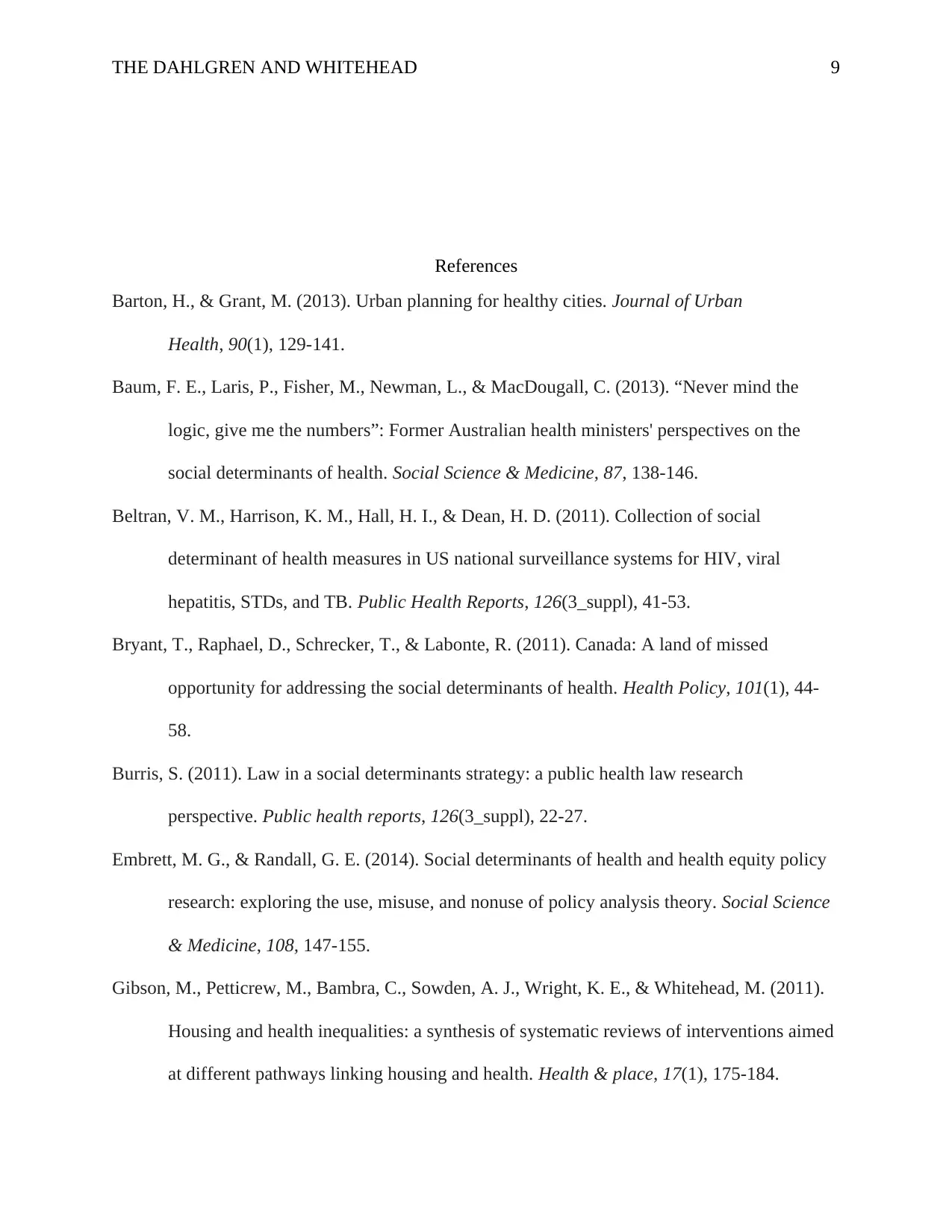
THE DAHLGREN AND WHITEHEAD 9
References
Barton, H., & Grant, M. (2013). Urban planning for healthy cities. Journal of Urban
Health, 90(1), 129-141.
Baum, F. E., Laris, P., Fisher, M., Newman, L., & MacDougall, C. (2013). “Never mind the
logic, give me the numbers”: Former Australian health ministers' perspectives on the
social determinants of health. Social Science & Medicine, 87, 138-146.
Beltran, V. M., Harrison, K. M., Hall, H. I., & Dean, H. D. (2011). Collection of social
determinant of health measures in US national surveillance systems for HIV, viral
hepatitis, STDs, and TB. Public Health Reports, 126(3_suppl), 41-53.
Bryant, T., Raphael, D., Schrecker, T., & Labonte, R. (2011). Canada: A land of missed
opportunity for addressing the social determinants of health. Health Policy, 101(1), 44-
58.
Burris, S. (2011). Law in a social determinants strategy: a public health law research
perspective. Public health reports, 126(3_suppl), 22-27.
Embrett, M. G., & Randall, G. E. (2014). Social determinants of health and health equity policy
research: exploring the use, misuse, and nonuse of policy analysis theory. Social Science
& Medicine, 108, 147-155.
Gibson, M., Petticrew, M., Bambra, C., Sowden, A. J., Wright, K. E., & Whitehead, M. (2011).
Housing and health inequalities: a synthesis of systematic reviews of interventions aimed
at different pathways linking housing and health. Health & place, 17(1), 175-184.
References
Barton, H., & Grant, M. (2013). Urban planning for healthy cities. Journal of Urban
Health, 90(1), 129-141.
Baum, F. E., Laris, P., Fisher, M., Newman, L., & MacDougall, C. (2013). “Never mind the
logic, give me the numbers”: Former Australian health ministers' perspectives on the
social determinants of health. Social Science & Medicine, 87, 138-146.
Beltran, V. M., Harrison, K. M., Hall, H. I., & Dean, H. D. (2011). Collection of social
determinant of health measures in US national surveillance systems for HIV, viral
hepatitis, STDs, and TB. Public Health Reports, 126(3_suppl), 41-53.
Bryant, T., Raphael, D., Schrecker, T., & Labonte, R. (2011). Canada: A land of missed
opportunity for addressing the social determinants of health. Health Policy, 101(1), 44-
58.
Burris, S. (2011). Law in a social determinants strategy: a public health law research
perspective. Public health reports, 126(3_suppl), 22-27.
Embrett, M. G., & Randall, G. E. (2014). Social determinants of health and health equity policy
research: exploring the use, misuse, and nonuse of policy analysis theory. Social Science
& Medicine, 108, 147-155.
Gibson, M., Petticrew, M., Bambra, C., Sowden, A. J., Wright, K. E., & Whitehead, M. (2011).
Housing and health inequalities: a synthesis of systematic reviews of interventions aimed
at different pathways linking housing and health. Health & place, 17(1), 175-184.
⊘ This is a preview!⊘
Do you want full access?
Subscribe today to unlock all pages.

Trusted by 1+ million students worldwide

THE DAHLGREN AND WHITEHEAD 10
Jinks, C., Ong, B. N., & O'Neill, T. (2010). " Well, it's nobody's responsibility but my own." A
qualitative study to explore views about the determinants of health and prevention of
knee pain in older adults. BMC Public Health, 10(1), 148.
Knol, A. B., Briggs, D. J., & Lebret, E. (2010). Assessment of complex environmental health
problems: Framing the structures and structuring the frameworks. Science of the Total
Environment, 408(14), 2785-2794.
Koh, H. K., Oppenheimer, S. C., Massin-Short, S. B., Emmons, K. M., Geller, A. C., &
Viswanath, K. (2010). Translating research evidence into practice to reduce health
disparities: a social determinants approach. American journal of public health, 100(S1),
S72-S80.
Krumeich, A., & Meershoek, A. (2014). Health in global context; beyond the social determinants
of health?. Global health action, 7(1), 23506.
McCartney, G., Thomas, S., Thomson, H., Scott, J., Hamilton, V., Hanlon, P., ... & Bond, L.
(2010). The health and socioeconomic impacts of major multi-sport events: systematic
review (1978-2008). BMj, 340, c2369.
Mogford, E., Gould, L., & DeVoght, A. (2010). Teaching critical health literacy in the US as a
means to action on the social determinants of health. Health Promotion
International, 26(1), 4-13.
Morgan, A., & Ziglio, E. (2010). Revitalising the public health evidence base: An asset model.
In Health assets in a global context (pp. 3-16). Springer New York.
Potvin, L. (2012). Intersectoral action for health: more research is needed!.
Raphael, D. (2011). A discourse analysis of the social determinants of health. Critical Public
Health, 21(2), 221-236.
Jinks, C., Ong, B. N., & O'Neill, T. (2010). " Well, it's nobody's responsibility but my own." A
qualitative study to explore views about the determinants of health and prevention of
knee pain in older adults. BMC Public Health, 10(1), 148.
Knol, A. B., Briggs, D. J., & Lebret, E. (2010). Assessment of complex environmental health
problems: Framing the structures and structuring the frameworks. Science of the Total
Environment, 408(14), 2785-2794.
Koh, H. K., Oppenheimer, S. C., Massin-Short, S. B., Emmons, K. M., Geller, A. C., &
Viswanath, K. (2010). Translating research evidence into practice to reduce health
disparities: a social determinants approach. American journal of public health, 100(S1),
S72-S80.
Krumeich, A., & Meershoek, A. (2014). Health in global context; beyond the social determinants
of health?. Global health action, 7(1), 23506.
McCartney, G., Thomas, S., Thomson, H., Scott, J., Hamilton, V., Hanlon, P., ... & Bond, L.
(2010). The health and socioeconomic impacts of major multi-sport events: systematic
review (1978-2008). BMj, 340, c2369.
Mogford, E., Gould, L., & DeVoght, A. (2010). Teaching critical health literacy in the US as a
means to action on the social determinants of health. Health Promotion
International, 26(1), 4-13.
Morgan, A., & Ziglio, E. (2010). Revitalising the public health evidence base: An asset model.
In Health assets in a global context (pp. 3-16). Springer New York.
Potvin, L. (2012). Intersectoral action for health: more research is needed!.
Raphael, D. (2011). A discourse analysis of the social determinants of health. Critical Public
Health, 21(2), 221-236.
Paraphrase This Document
Need a fresh take? Get an instant paraphrase of this document with our AI Paraphraser
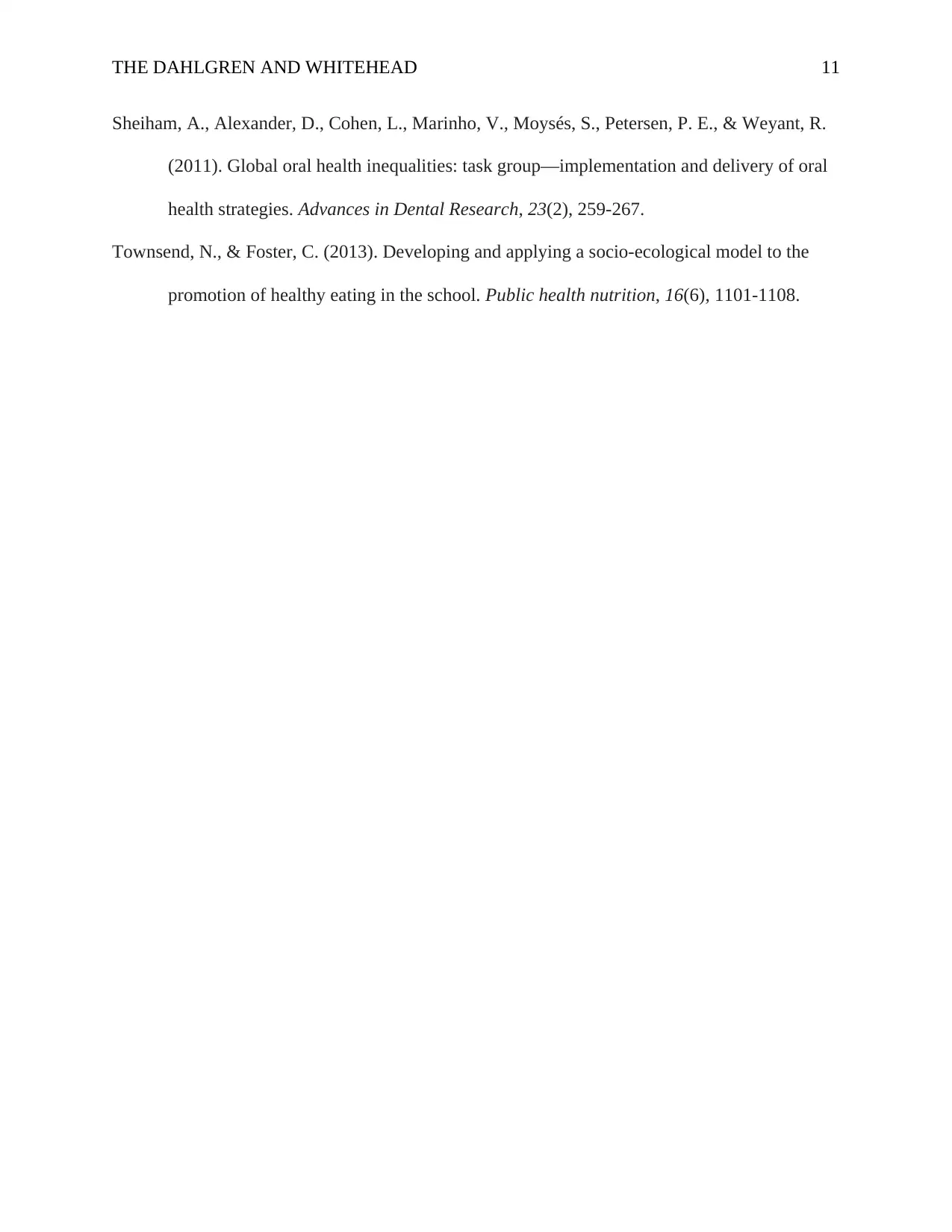
THE DAHLGREN AND WHITEHEAD 11
Sheiham, A., Alexander, D., Cohen, L., Marinho, V., Moysés, S., Petersen, P. E., & Weyant, R.
(2011). Global oral health inequalities: task group—implementation and delivery of oral
health strategies. Advances in Dental Research, 23(2), 259-267.
Townsend, N., & Foster, C. (2013). Developing and applying a socio-ecological model to the
promotion of healthy eating in the school. Public health nutrition, 16(6), 1101-1108.
Sheiham, A., Alexander, D., Cohen, L., Marinho, V., Moysés, S., Petersen, P. E., & Weyant, R.
(2011). Global oral health inequalities: task group—implementation and delivery of oral
health strategies. Advances in Dental Research, 23(2), 259-267.
Townsend, N., & Foster, C. (2013). Developing and applying a socio-ecological model to the
promotion of healthy eating in the school. Public health nutrition, 16(6), 1101-1108.
1 out of 11
Related Documents
Your All-in-One AI-Powered Toolkit for Academic Success.
+13062052269
info@desklib.com
Available 24*7 on WhatsApp / Email
![[object Object]](/_next/static/media/star-bottom.7253800d.svg)
Unlock your academic potential
Copyright © 2020–2025 A2Z Services. All Rights Reserved. Developed and managed by ZUCOL.




